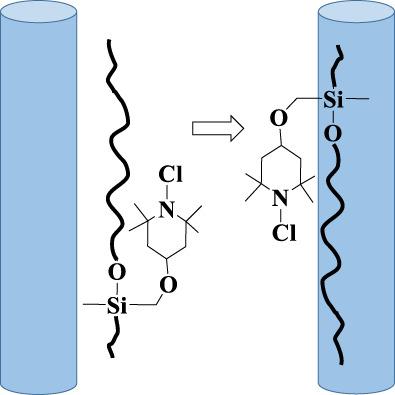当前位置:
X-MOL 学术
›
J. Appl. Polym. Sci.
›
论文详情
Our official English website, www.x-mol.net, welcomes your
feedback! (Note: you will need to create a separate account there.)
Preparation of silicone containing 2,2,6,6‐tetramethyl‐4‐piperidinol‐based N‐chloramine for antibacterial polyethylene via interpenetration in supercritical carbon dioxide
Journal of Applied Polymer Science ( IF 2.7 ) Pub Date : 2019-02-07 , DOI: 10.1002/app.47614 Yong Chen 1 , Yuyu Wang 1 , Qiang Zhang 2 , Cuiying Yang 3 , Qiuxia Han 4
Journal of Applied Polymer Science ( IF 2.7 ) Pub Date : 2019-02-07 , DOI: 10.1002/app.47614 Yong Chen 1 , Yuyu Wang 1 , Qiang Zhang 2 , Cuiying Yang 3 , Qiuxia Han 4
Affiliation

|
Functionalization of polyethylene (PE) with powerful biocides through a friendly and efficient procedure is necessary to obtain extended applications. A novel CO2‐philic 2,2,6,6‐tetramethyl‐4‐piperidinol (TMP)‐based N‐chloramine silicone was synthesized via Pt‐catalyzed silane alcoholysis between the SiH of poly(methylhydrosiloxane) and OH of TMP and followed by chlorination of amine NH originating from TMP to NCl. The TMP‐based N‐chloramine silicone was interpenetrated into PE using supercritical carbon dioxide (scCO2) as working solvent. It was shown that the thickness of the TMP‐based N‐chloramine silicone layer on PE can be easily controlled by the interpenetration pressure, reaching a maximum value of 70 nm at 28 mp. The synthetic procedures and the interpenetration results were characterized by Fourier transform infrared, scanning electron microscopy, and X‐ray photoelectron spectroscopy. In contrast with pristine PE that did not show biocidal ability, the TMP‐based N‐chloramine silicone modified PE imparted powerful antibacterial abilities, exerting total kills of both Staphylococcus aureus and Escherichia coli of ~107 cfu mL−1 in 30 min. The biocidal functionality was durable toward washings, storage, and ultraviolet exposure and the recoverability of lost chlorines was good. The interpenetration in scCO2 tactic provides an environmentally friendly and universal approach to functionalize inert substrates due to no needs of harmful solvent and chemical linkages with biocides. © 2019 Wiley Periodicals, Inc. J. Appl. Polym. Sci. 2019, 136, 47614.
中文翻译:

通过在超临界二氧化碳中互穿制备含2,2,6,6-四甲基-4-哌啶醇基N-氯胺的有机硅用于抗菌聚乙烯
为了获得广泛的应用,必须通过一种友好而有效的程序将功能强大的杀菌剂与聚乙烯(PE)进行功能化。一种新的CO 2 -philic 2,2,6,6-四甲基-4-哌啶醇(TMP)为基础的Ñ -chloramine硅酮经由所述Si之间的Pt催化的醇解硅烷合成聚H(甲基氢硅氧烷)和O ħ TMP和随后胺N-氯化从TMP到Nħ始发氯。使用超临界二氧化碳(scCO 2)作为工作溶剂,将基于TMP的N-氯胺有机硅渗透到PE中。结果表明,基于TMP的氮的厚度PE上的氯胺有机硅层可以很容易地通过互穿压力控制,在28 mp时达到70 nm的最大值。通过傅里叶变换红外光谱,扫描电子显微镜和X射线光电子能谱对合成过程和互穿结果进行了表征。与未显示出杀菌能力的原始PE相比,基于TMP的N-氯胺硅氧烷改性的PE具有强大的抗菌能力,对金黄色葡萄球菌和大肠杆菌的总杀灭力约为10 7 cfu mL -1在30分钟内 杀菌功能对洗涤,储存和紫外线照射具有持久性,氯损失的可回收性也很好。由于不需要有害溶剂以及与杀生物剂的化学键合,scCO 2策略中的互穿提供了一种环保且通用的方法来对惰性底物进行功能化。分级为4 +©2019 Wiley Periodicals,Inc.J.Appl。Polym。科学 2019,136,47614。
更新日期:2019-02-07
中文翻译:

通过在超临界二氧化碳中互穿制备含2,2,6,6-四甲基-4-哌啶醇基N-氯胺的有机硅用于抗菌聚乙烯
为了获得广泛的应用,必须通过一种友好而有效的程序将功能强大的杀菌剂与聚乙烯(PE)进行功能化。一种新的CO 2 -philic 2,2,6,6-四甲基-4-哌啶醇(TMP)为基础的Ñ -chloramine硅酮经由所述Si之间的Pt催化的醇解硅烷合成聚H(甲基氢硅氧烷)和O ħ TMP和随后胺N-氯化从TMP到Nħ始发氯。使用超临界二氧化碳(scCO 2)作为工作溶剂,将基于TMP的N-氯胺有机硅渗透到PE中。结果表明,基于TMP的氮的厚度PE上的氯胺有机硅层可以很容易地通过互穿压力控制,在28 mp时达到70 nm的最大值。通过傅里叶变换红外光谱,扫描电子显微镜和X射线光电子能谱对合成过程和互穿结果进行了表征。与未显示出杀菌能力的原始PE相比,基于TMP的N-氯胺硅氧烷改性的PE具有强大的抗菌能力,对金黄色葡萄球菌和大肠杆菌的总杀灭力约为10 7 cfu mL -1在30分钟内 杀菌功能对洗涤,储存和紫外线照射具有持久性,氯损失的可回收性也很好。由于不需要有害溶剂以及与杀生物剂的化学键合,scCO 2策略中的互穿提供了一种环保且通用的方法来对惰性底物进行功能化。分级为4 +©2019 Wiley Periodicals,Inc.J.Appl。Polym。科学 2019,136,47614。





















































 京公网安备 11010802027423号
京公网安备 11010802027423号